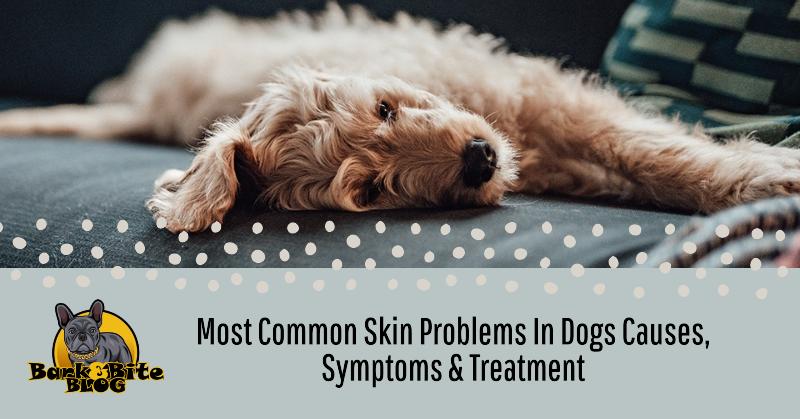Everybody has had the experience of wishing their pets could communicate, particularly when they refuse to stop licking and clawing their skin and leaving us wondering. My dear, what’s wrong? Serious infections to small irritations are among the Common Skin Problems In Dogs that affect your dog. It is a sign of underlying health issues that require appropriate treatment and goes beyond simple discomfort.
Dogs’ general health and wellbeing depend greatly on having healthy skin. It controls body temperature, acts as a barrier to keep out infections, and supports immune system activity.
Read on for information about often occurring Common Skin Problems In Dogs, how to take care of them, and healthy dog shampoos you may use on your pet.
1. Contact dermatitis allergic
Factors and Signs of Common Skin Problems In Dogs
There are two main reasons that it induces allergic dermatitis in dogs.
- allergies to the surroundings
- allergy foods are sometimes not the culprits
** Dust mites, mold; pollen; grass; soil; and other materials that come into contact with your pet’s body might result in environmental allergies. This might result in symptoms, especially on their face and paws, including licking, gnawing, rubbing, or itching.
However, certain wheat, soy, and protein products can cause food sensitivities.When eaten, it damages the skin and digestive system of the dog.
Early warning indicators and symptoms include redness, swelling, itching, and recurring infections of the ears are frequently observed.
Treatment Advice: To start treating your dog skin diseases, determine which dietary or environmental allergy is to blame and avoid it. This could entail altering the surroundings, changing the feed, and adhering to additional advice from your veterinarian.
2. Worms on Rings: Common Skin Problems In Dogs
Factors and Signs
As the name implies, ringworm is not actually caused by worms, but rather by a fungus. Even though the disease is very contagious, dogs with weakened immune systems are more prone to getting it.
The signs include red, scaly skin and hair loss that appears as ring- or circular-shaped spots. It could have raised lumps; puss-filled sores; or itchy skin as well.
Treatment Advice: Antifungal shampoos, oral medicines, and pet itch heals can all be used to treat ringworm diseases.
3. Pyoderma: Common Skin Problems In Dogs
Factors and Signs
Dogs that have allergies, parasites, aberrant hormone levels, or other common canine skin conditions may develop pyoderma, a bacterial infection. Tumors loaded with pus, redness, and discomfort are some of the symptoms. It can be quite painful; take precautions.Deep pyoderma is more painful and affects the roots of hair in addition to the deeper layers of the skin. Deep pyoderma affects the skin’s outer layer.
Treatment Advice: Veterinarians frequently advise treating inflammatory skin with medicated shampoos, sprays, and baths. To eradicate bacterial infections, oral antibiotics are prescribed for pyoderma treatment in addition to these fundamental treatments.
4. The seborrhea: Common Skin Problems In Dogs
Factors and Signs
Dogs with the skin illness seborrhea produce too much oil, a fat released by the skin pores.
Among the symptoms include thick, crusty patches, oily or flaky skin, and a bad smell. The dog’s tummy, between its toes, under armpits, and the base of its neck are among the skin sections most severely impacted.
In addition to redness; profuse dandruff; itching; and hair loss; this skin ailment also manifests other symptoms.
Treatment Advice: It’s important to keep the afflicted area clean to stop new infections. Medicated shampoo baths or topical cream applications to get rid of extra oil and scale are two possible treatment alternatives.
5. An infection with yeast
Factors and Signs of Common Skin Problems In Dogs
The yeast species are dominant. Dog yeast infections are frequently brought on by Malassezia on the skin. Numerous factors, such as hormonal imbalances, allergies, and more serious canine skin diseases, can result in yeast overgrowth.
Among the symptoms include redness, irritation, greasy discharge, odor, and irritated skin. Additionally; dogs may lick; chew, or itch in the afflicted areas; which could result in more skin damage.
Treatment Advise: Skin infections caused by yeast may take many weeks to recover. Along with routinely bathing the dog, make sure you follow the doctor’s directions to boost their immunity.
Drugs that inhibit yeast growth, such as antifungal and antipruritic ones, are frequently in use to treat yeast infections.
6. Ticks and Fleas
Factors and Signs of Common Skin Problems In Dogs
Frequently observed external parasites on dogs’ coats or skin, fleas and ticks feed on the skin and spread viral infections through saliva!
Adverse skin irritation symptoms include visible parasites; flea filth on the skin; and vigorous skin chewing and scratching.
In severe situations; dogs may experience allergic reactions; anemia from blood loss (particularly in small or puppy breeds); or even spread the parasite-borne illness.
Treatment Advice: Fleas and ticks can be identify and avoided with regular grooming and environmental hygiene.
Test with natural and ayurvedic dog shampoos! Its antifungal and anti-inflammatory qualities lessen irritability and attract infections.
7. Lupus: Common Skin Problems In Dogs
Factors and Signs
The immune system malfunctioning that results in the body attacking its cells causes lupus; an autoimmune illness. Lesions on the nose; paws; and eyes; are among the symptoms; along with skin scaling and hair loss. Your dog may occasionally become more tired; have less appetite; and experience joint pain.
Treatment Advice: The aim of treatment is to prevent aberrant immune responses by using immunosuppressive drugs such as vitamin E supplements and corticosteroids. Moreover, incorporating antioxidants like beta-carotene, vitamins A, C, and E into the dog’s diet greatly boosts their immunity.
8. Alopecia: Common Skin Problems In Dogs
Factors and Signs
Many medical conditions; such as hormone imbalances; allergies; parasites; heredity; and autoimmune illnesses; can cause alopecia; or hair loss; in dogs.
One or more sections of the dog’s body may have patches of exposed skin or hair loss as symptoms. Dogs who have itchy or irritated skin may also experience it as well.
Treatment Advice: In order to offer an efficient course of action; it is imperative to determine the underlying cause of the illness.
Supplemental fatty acids; treating infections and parasites; changing one’s diet; and taking up good grooming techniques are some further preventative measures.
9. Mange: Common Skin Problems In Dogs
Factors and Signs
Dogs who have mites on their skin and in their hair follicles develop mange. There are two different kinds of mange: Sarcoptic mange (caused by Sarcoptes scabiei mites); and Demodectic mange (produced by Demodex mites).
Direct contact with contaminated environments or animals with the infection can spread mites.
Bald spots on the face and around the eyes; redness; and thicker; scaly; crusty skin are some of the symptoms.
Treatment Advice: To eradicate mites and reduce symptoms; oral or topical drugs are frequently used in the treatment of mange.
Medication baths with certain shampoos are another recommendation made by veterinarians to reduce irritation and speed up the healing process.
Next time you read about dog skin; remember your furry friend needs special attention and care!
Final Thoughts on Common Skin Issues in Dogs
For our beloved friends to stay healthy; we must take good care of their skin and coats.
Pause to consider; are we giving their skin care and grooming enough time?. They are limited to scratching and itching in order to relieve irritation; but you know you are capable of more.
Let’s promise to do our share to maintain their happiness and well-being.
We at BarkAndBiteBlog are aware of your deep devotion for your pet. Discover the world of dog friendship with BarkandBiteblog. This site is a goldmine of knowledge for dog lovers; whether you’re looking for expert advice on training or just interesting facts about your furry pals.





